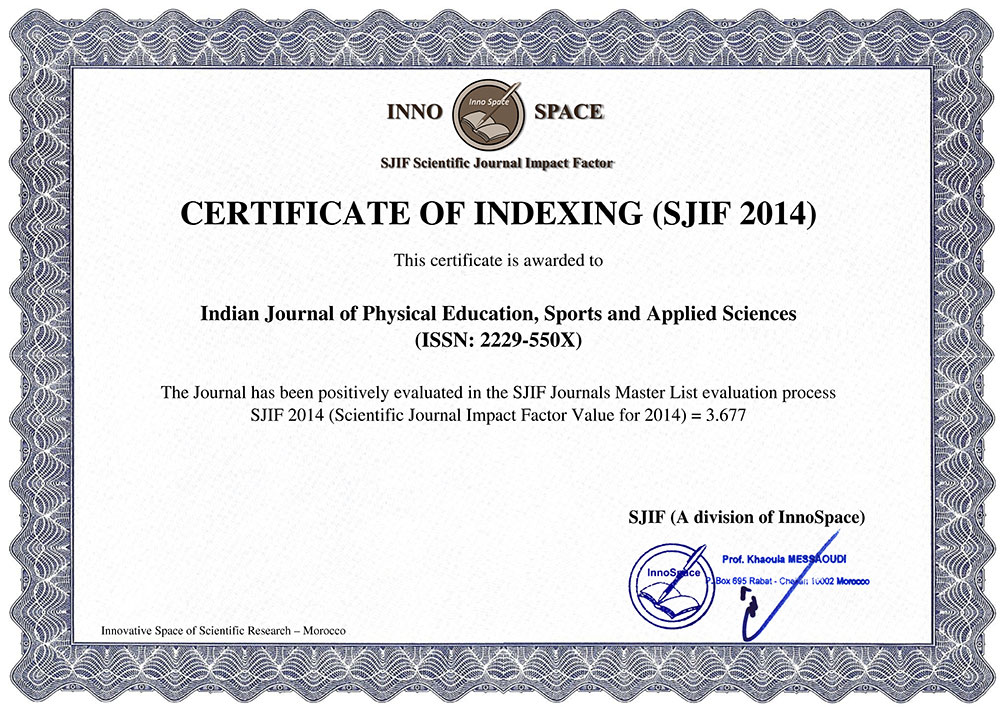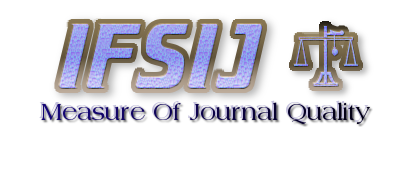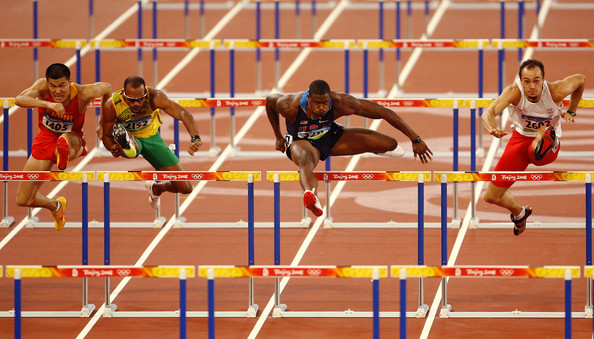DIFFERENCES IN MOTIVATION FOR PARTICIPATION IN SPORTS AMONG MALE AND FEMALE YOUTH OF GOA
Volume 7-Number 4, October, 2017 November 5, 2017| Author name : | Shreenivas Harikanth and Gajanana Prabhu B. | ||||
|---|---|---|---|---|---|
| Page no : | 01-05 | Volume : | 7 | Issue : | 4 |
doi no.: 05-2016-44975451, DOI Link :: http://doi-ds.org/doilink/11.2017-64888132/
Shreenivas Harikanth 1 and Gajanana Prabhu B. 2
Affiliations
1 Research Scholar, Department of P.G. Studies and Research in Physical Education, KuvempuUniversity, Shimoga, Karnataka 577451 INDIA
2 Assistant Professor, Department of P.G. Studies and Research in Physical Education, Kuvempu University, Shimoga, Karnataka INDIA Email: prabhuji888@gmail.com
ABSTRACT
Sports is undoubtedly a fantastic way to keep oneself physically fit, mentally alert, socially well-adjusted and emotionally balanced. Motivation is the foundation all athletic effort and accomplishment. It is the ability to initiate and persist at a task. Measures have to be taken to identify the key motives for sports motivation in the youth of Goa in order to keep them moving. The purpose of the present investigation was to examine the differences in motivation for participation in sports in youth of Goa on the basis of gender. The subjects for the study 254 young men (N=173) and women (N=81) of Goa state participating in sports at various levels. Minimum inter-collegiate participation was the inclusion criteria adopted for the study. Hindi translated revised version of Sport Motivation Scale (SMS-6) with six factor by Mallett, et. al. (2007) was adopted for collecting data on motivation for participation in sports. The data was collected by the investigator during spare time of the subjects with proper orientation. Independent sample ‘t’ test was calculated along with mean and standard deviation. It is concluded that the female sports persons are higher in motivation for participation in sports as compared to their male counterparts in Goa. Female have higher external regulation, identified regulation and overall sports motivation; whereas male have higher intrinsic motivation.
Keywords:Goa, globalization, sports, motivation, gender.
DOWNLOAD FULL TEXT: 
BIBLIOGRAPHY
Amorose AJ., Horn, TS., (2000). Intrinsic motivation: Relationships with collegiate athletes’ gender, scholarship status, and perceptions of their coaches’ behavior. Journal of sport & exercise psychology,22(1-4), 63-84.
Amorose, A. J., Anderson-Butcher, D. (2007). Autonomy-supportive coaching and self-determined motivation in high school and college athletes: A test of self-determination theory. Psychology of Sport and Exercise,8(5), 654-670.
Amorose, A. J., Anderson-Butcher, D. (2007). Autonomy-supportive coaching and self-determined motivation in high school and college athletes: A test of self-determination theory. Psychology of Sport and Exercise,8(5), 654-670.
Deci, E. & Ryan, R. (1985). Intrinsic motivation and self-determination in human behaviour. New York: Plenum.
Fernandes, A. C., Hayes, R. D. and Patel, V. (2012) “Abuse and other correlates of common mental disorders in youth: a cross-sectional study in Goa, India”, Social Psychiatry Psychiatric Epidemiology; reviewed on line DOI 10.1007/s00127-012-0614-6
Gacar, A. (2013) “Examination of sport-specific achievement motivation level of super league handball players in universities”, European Journal of Experimental Biology, 3(1):181-184.
Gokhale, K., Sawant, N. and Ugavekar, N. (2014) “Goa: Tourism and Socio-Cultural Implications A Study Of Selected Tourist Destination of South Goa District, Goa-India”, IOSR Journal Of Humanities And Social Science (IOSR-JHSS) Volume 19, Issue 10, Ver. I (Oct. 2014), PP 36-41.
Jiteshwor, P. Sunderlal, N. Singh, R. gharayaghzandi, H. G. and Singh, N. J. (2013) “Comparative study of the Sports Achievement Motivation between Male and Female School Basketball Players”, IOSR Journal of Humanities and Social Science, Volume 7, Issue 2; PP 23-26.
Krishna Menon, A. G. (1993) “Case study on the effects of tourism on culture and the environment: India; Jaisalmer, Khajuraho and Goa”, Bangkok, UNESCO, 99 p. (RACAP Series on Culture and Tourism in Asia.
Mallett, C., Kawabata, M., Newcombe, P., Otero-Forero, A. & Jackson, S. (2007) “Sport motivation scale-6 (SMS-6): A revised six factor sport motivation scale”, Psychology of sport and exercise; Vol-8; PP:600-614.
Pelletier, L.G., Fortier, M.S., Vallerand, R.J., Tuson, K.M., Brière, N.M. and Blais, M.R. (1995a) Toward a new measure of intrinsic motivation, extrinsic motivation, and amotivation in sports: the Sport Motivation Scale (SMS). Journal of Sport and Exercise Psychology 17, 35-53.
Sarmento, H., Catita, L. and Fonseca, A. (2008) “Sport motivation – a comparison between adult football players competing at different levels”, Kinesiology Research Trends and Applications; Procedings of 5th International Scientific Conference on Kinesiology, 2008, Zagreb, Croatia; PP: 631-634.
Sarmento, H., Catita, L. and Fonseca, A. (2008) “Sport motivation – a comparison between adult football players competing at different levels”, Kinesiology Research Trends and Applications; Procedings of 5th International Scientific Conference on Kinesiology, 2008, Zagreb, Croatia; PP: 631-634.
Shridhar, K., Millett, C., Laverty, A. A., Alam, A. Dias, A., Williams, J and Dhillon, P. K. (2016) “Prevalence and correlates of achieving recommended physical activity levels among children living in rural South Asia—A multi-centre study”, Vol- 16:690; DOI 10.1186/s12889-016-3353-x
Soyera, F., Sari, I., Talaghirb, L. (2014) “The relationship between perceived coaching behaviour and achievement motivation: a research in football players”, Procedia – Social and Behavioral Sciences; Vol-152 ; PP:421 – 425.







